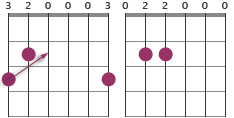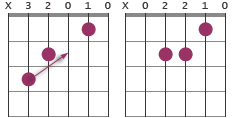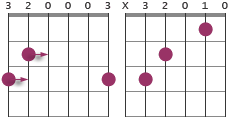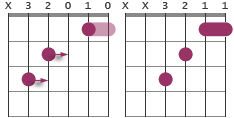How to switch between chords
 After learning guitar chords and the correct fingerings, you should begin exercising in moving efficiently from one chord to another. The progress will be slow in the beginning, but after a while you get better at it.
After learning guitar chords and the correct fingerings, you should begin exercising in moving efficiently from one chord to another. The progress will be slow in the beginning, but after a while you get better at it.
Economy in movements
The key to moving fast from one chord to another is economy in the movements. The critical thing about switching between chords is avoiding unnecessary movements. If not necessary, you shouldn't lift your whole hand from the fretboard but only move the involved fingers to new positions. And if some fingers share the same positions in the "leaving-chord" and "the-going-to-chord", you should of course not move them at all.
This concept of common finger (finger or fingers that remain on the same position through changes) that are is illustrated with examples below:
G to Em

A common changing is G major to E minor. There is one shared note, the note on 5th string, 2nd fret. The key is of course to not move this, for which either the index or middle finger can be used.
C to Am

Changing from C major to A minor or the vice versa is one of the easiest actions involving common chords. Two out of three positions are shared, therefore you only need to move one finger, which should be the index. Try also in the same movement slide back some with the fingers when going from C to Am to give room for the finger on the 3rd string.
The concept of common finger is illustrated in this collection of chord progressions (pdf).
A helpful method is to think of your fingers as clusters instead of single entities. In other words: try to move two or three fingers in a group and put them down simultaneously. This is critical for being able to switch fast between chords.
G to C

The technical theme here is to move a finger pair one string in vertical direction. In addition, the index finger should be landing on the first fret. The easiest way is to use the 2, 3, 4 fingering for the G major.
C to F

A similar theme is used for this changing. In addition, you should fold down the index finger on the 2nd string to make it lay over two strings.
Be sure that you use the right fingerings and notice that depending on chord sequences the fingering can shift. The ideal fingerings are what makes the switch to the next chord the most economical.
Another concept in this area is that of guide finger. It is similar with the concept of common finger with the difference that the guide finger can move between frets, but stays on the same string. This is illustrated in this chord progression (pdf).
Then it comes to movable chords, such as barre chords, you should, once again, strive for small movements in most cases. To accomplish this you may have to learn two different chord shapes, which allow you to use more than one string for the bass note in the chord.
There’s not very much more to say on this subject – it's not theory that make you succeed in this area but practice. As you're practicing different chord changes, you will by time be able to move easily between chords.
Here are some progressions with easy chord changing:
C - Am - Fmaj7
E - Am - D7
G - Em - C
Strum on open strings in between
Sometimes the tempo is high and you cannot shift chords in accurate tempo. In that case it's better to lift all fingers and strum over only open strings between the chords instead of strum a partly ready chord position. To explain further: you should strive to place all fingers together instead of one at the time, which will make it sound bad. So, if the tempo is high, do an in-between stroke over open strings and when put down the fingers together as a cluster on the new chord and continue the strumming. This will not work in all occasions if the open strings not working musically with the chords, but often it will.
More tips about chord changes plus exercises.
Follow chord changes in a song
To hear when the chord changes in a song can be difficult, and even harder is it to hear which exact chords are involved. To figure out the chords in a song you must have a pretty good “music ear” and that is something that takes time to develop. The best way to train at this is to listen carefully at songs and try to imitate what you hear.